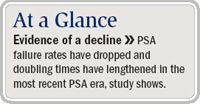Article
PSA data support drop in PCa-specific mortality
Orlando, FL--The PSA era has been marked by a well-known stage migration toward less aggressive and potentially more curable prostate cancer. Research now shows that, during the recent PSA era, PSA doubling times have lengthened and PSA failure rates have dropped. The findings suggest that prostate cancer-specific mortality will continue to decline, according to researchers from Tufts University and the Dana-Farber Cancer Institute, Boston.

The study's authors set out to determine whether stage migration during the PSA era has translated into longer PSA doubling times in men who experience PSA failure. Many investigators looking at indicators of mortality repeatedly have found that the length of PSA doubling time is such an indicator: A short PSA doubling time appears to be a surrogate endpoint for prostate cancer mortality.
In a poster presentation at the American Society of Clinical Oncology annual meeting, the researchers discovered a significant decrease in the proportion of patients with a postoperative PSA doubling time of less than 3 months, reported Shira L. Galper, a Tufts University fourth-year medical student working with Anthony V. D'Amico, PhD, and colleagues.
"The question is: What does biochemical failure, a rise in PSA levels, indicate?" Galper asked. "Does it indicate mortality? Is there an issue of lead-time bias? Are people dying of prostate cancer or merely with prostate cancer?
"Whether the prostate cancer-specific mortality rate will decline with the use of PSA-based screening can only be answered by the randomized screening studies. However, an assessment of how PSA doubling times have changed during the PSA era may provide information regarding the impact PSA screening may have on mortality," she said.
Two PSA eras compared The researchers compared preoperative and postoperative characteristics and 5-year actual PSA failure rates and doubling times in patients treated during two equal periods: the early PSA era, from July 1988 to July 1995; and the late PSA era, from August 1995 to July 2002. They found a 37% reduction in the proportion of patients with PSA doubling times of less than 3 months, corresponding to a decrease in absolute magnitude from 9% to 5.7% between the two eras. In addition, PSA doubling times >12 months increased by 15.3%.
"Patients who sustained biochemical failure had longer PSA doubling times in the later PSA era than in the earlier era," Galper said. "We hypothesize there will be a decline in prostate cancer-specific mortality as a result of PSA screening being instituted and initiating earlier treatment."
Newsletter
Stay current with the latest urology news and practice-changing insights — sign up now for the essential updates every urologist needs.















